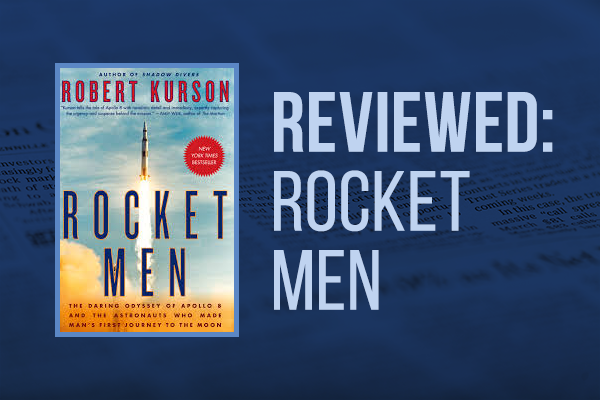The 50th anniversary of the first Moon walk – by American Neil Armstrong, commander of the Apollo 11 mission – was celebrated on July 20, 2019. It fulfilled the vision of the murdered President John F. Kennedy when in 1961 he committed the U.S. to achieving the goal of landing a man on the Moon and returning him safely to earth by the end of the decade.
But many in the space industry contend that a lesser-known flight – Apollo 8 in 1968, the first mission to fly around the Moon – was equally significant, if not more so, because of the risks it entailed. That event is recount- ed in Rocket Men, by author/ journalist Robert Kurson (373 pp; © 2018, Random House).
The mission wasn’t even on the drawing board in August 1968. Four months later, on Dec. 21, Frank Borman, Jim Lovell and Bill Anders were strapped into a Saturn V rocket at Cape Canaveral (then known as Cape Kennedy) and launched toward outer space. Nearly everything that went into planning the lunar fly-by mission was “rushed to the launchpad in a fraction of the time ordinarily required,” the author notes.
A key catalyst for the hurried mission was the Cold War space race between the U.S. and the U.S.S.R. The Russians lofted the world’s first satellite (the 184-pound Sputnik) into or- bit in 1957 and launched the first man (cosmo- naut Yuri Gagarin) into outer space in 1961.
The Soviets’ Zond 6 unmanned spacecraft passed within 1,500 miles of the Moon in November 1968. America’s Apollo 8 crew, though, would be the first men to arrive at the Moon and the first humans to view its far side, and they flew within 68 miles of the Moon’s surface.
Lovell and Anders both hoped to eventually walk on the Moon. Borman, though, “had little interest in exploration, adventure or pioneer- ing. He didn’t thrive on speed or adrenaline,” Kurson reveals. Borman joined NASA for “a single purpose: to fight the Soviet Union on the world’s new battlefield, outer space.”
The vehicle chosen to deliver Apollo 8 to the Moon was the colossal Saturn V rocket. It was 36 stories tall; laid on its side it was 363 feet long, end-to-end – longer than a football field.
The Saturn V rocket contained nearly a million gallons of propellant (highly refined kerosene, liquid hydrogen and liquid oxygen);
its engines burned 15 tons of propellant per second. Fully fueled the rocket weighed 6.5 million pounds, and it produced 7.6 million pounds of thrust – equivalent to 160 million horsepower – at launch. It was “the most powerful machine ever built,” Kurson writes.
The Apollo 8 rocket had 5.6 million parts and 1.5 million systems, subsystems and assemblies. Even if the machine functioned with 99.9% reliability, 5,600 defects might occur, a NASA official pointed out. The Saturn V had flown just twice before – never with men aboard – and the most recent of those flights “failed catastrophically.”
Another concern of NASA was that if Borman’s crew died in space, “no one ... will ever look at the Moon the same way again,” said the late Jim Webb, then NASA’s administrator.
No insurance company would underwrite an astronaut, because of the extremely hazardous nature of their profession. Nevertheless, the Apollo 8 crew welcomed the mission. As military aviators, they were accustomed to risk. Death constantly stalks fighter pilots, test pilots and astronauts.
Anders fell asleep while on the launch pad, just as Oklahoma’s Gordon Cooper did in 1963 aboard his Faith 7 Mercury capsule.
Stress from the inherent hazards of their job, coupled with the countless hours spent in training, imposed a strain on every astronaut’s marriage and family. One day Anders calculated the amount of time he spent with each of his five kids: 11 minutes per week per child.
Of the first 30 American space couples, only seven of them stayed together, Lily Koppel wrote in The Astronaut Wives Club. Apollo 8 was the only crew in which all of the marriages survived, Kurson discovered.
Susan Borman had believed, “with 100% certainty,” that her husband would die aboard Apollo 8. So, after six years with NASA, Borman notified the agency that Apollo 8 would be his last mission in space. By then he “had come to see the stress his career placed on Susan [she became an alcoholic chain-smoker], and he couldn’t have any more of that,” Kurson writes.
The six-day Apollo 8 mission was virtually flawless, although during initial stages of the launch the noise was deafening and the cabin shook “violently,” the astronauts said.
During the flight Anders snapped the iconic “Earthrise” photo on Christmas Eve 1968. Afterward he said the astronauts had flown in space to discover the Moon but actually discovered the Earth.


